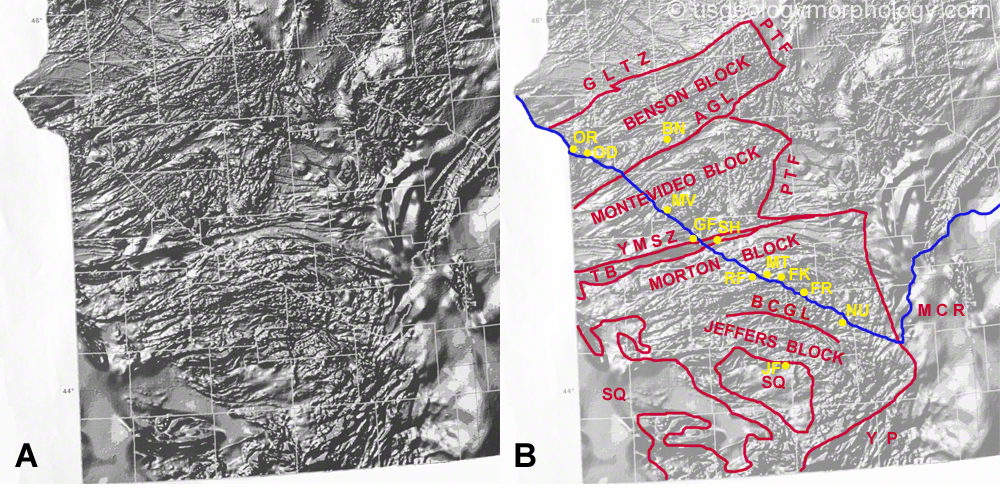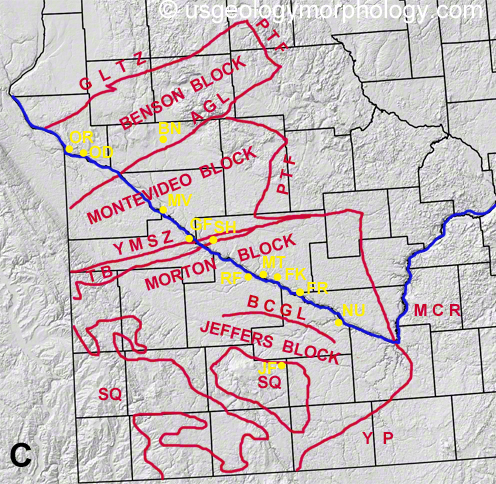The Archean Terranes of Minnesota (cont.)
4 The Minnesota River Valley Subprovince
Southwestern Minnesota is underlain by the oldest rocks of Minnesota in an area called the Minnesota River Valley subprovince, because the only visible outcrops are in the valley. Like most Precambrian rocks in the state, these rocks, after being flattened out by erosion, had been covered by younger rocks, first in the Southwest by the Paleoproterozoic Sioux quartzite, then in the West by varied Cretaceous sediments, and finally everything was buried by glacial deposits in the Quaternary.
About 11,700 years BP, when the ice sheet of the Wisconsin glacial age began to thaw, a huge lake, Lake Agassiz, formed in Minnesota, the Dakotas and Canada, as the melted ice was blocked by remaining ice and moraine blocks. Finally, part of its water poured southeastward into the glacial river Warren, the ancestor of upstream Minnesota River. Huge amounts of water carrying debris cut through the sediments a 5 km-wide channel, the present Minnesota River Valley, uncovering the Archean rocks.
These rocks, mostly gneiss and granite, can now be observed in many outcrops in the upper Minnesota River valley between Ortonville and New Ulm. They lie in four distinct northeastern trending belts, from North to South, the Benson, Montevideo, Morton and Jeffers blocks, separated by distinct boundaries. Since the outcrops are limited to the valley, the full extent of these belts has been inferred from aeromagnetic maps, gravity maps and drill holes.
Figure 4 shows how visible are the four blocks of the MRV on a shaded-relief aeromagnetic anomaly map. Contour maps of magnetic intensities are difficult to read; therefore it is convenient to map magnetic anomalies in the same way as elevations. Here illumination is supposed to come from the northwest, and wide, dark "slopes" are indicators of high magnetic intensities, or, to be more exact higher intensity contrasts. The base map used here is a excerpt of a digitized map from the Minnesota Geological Survey (MGS). Interpretation of an aeromagnetic map is a complex process and several data sources are used to draw conclusions. However, it is remarkable how the different physical units of the area stand out on such a map. Red lines have been overlain to show their boundaries. White county lines were already part of the MGS map; the Minnesota River (blue) and a few towns (yellow) have been added.
Figure 4-1. Blocks and lineaments of the Minnesota River Valley subprovince.

4-1A, 4-1B. Aeromagnetic map of the Minnesota River Valley subprovince showing its blocks and lineaments.
(A) Shaded-relief aeromagnetic anomaly map of southwest Minnesota. Darker “slopes” have higher magnetic intensity. Illumination from the northwest. (B) Interpreted aeromagnetic map showing the blocks and their boundaries. The Minnesota River Valley subprovince is divided into four blocks (Benson Block, Montevideo Block, Morton Block and Jeffers Block) shown on the aeromagnetic map. Major lineaments and belt boundaries in red. AGL-Appleton Geophysical Lineament, BCGL-Brown County Geophysical Lineament, GLTZ-Great Lakes Tectonic Zone, MCR-Mid-Continent Rift, PTF-Penokean Tectonic Front, SQ-Sioux Quartzite basins, TB-Taunton Belt, YMSZ-Yellow Medicine Shear Zone, YP-Yavapai Province. Minnesota River in blue. Towns in yellow: BN-Benson, FK-Franklin, FR-Fort Ridgely, GF-Granite Falls, JF-Jeffers, MT-Morton, MV-Montevideo, NU-New Ulm, OR-Ortonville, OD-Odessa, RF-Redwood Falls, SH-Sacred Heart. County lines in white. Base map: Courtesy of the Minnesota Geological Survey (Chandler, 1991) - Original size and resolution reduced. Modified by geo-referencing. Software: Quantum GIS.

4-1C. Shaded-relief map with blocks and lineaments of the Minnesota River Valley terrane.
Shading shows actual relief. Same symbols and abbreviations as above. County lines in black. Base map: GMTED data, Courtesy of the US Geological Survey. Software: Quantum GIS.
4.1 Benson Block
The Benson block is the northernmost of the four belts. Its boundaries are:
-to the north, the Great Lakes Tectonic Zone, also called the Morris Fault, which marks the limit with the Wawa granite-greenstone subprovince,
-to the east, the Penokean Tectonic Front which separates the Benson nlock from the Animikie Basin, a part of the Proterozoic Penokean orogen
-to the south, the Appleton Geophysical Lineament, where the Montevideo block begins.
To the west it is buried under deep Cretaceous sediments as it extends into South Dakota.
Outcrops are a very few, chiefly between Ortonville and Odessa, and this block has been less studied than the Montevideo and Morton blocks. Lund (1956) studied the Ortonville granite in the Ortonville-Odessa area. It is mostly pink in color, variable in composition with microcline as the principal mineral (40-60% in mode), followed by oligoclase and quartz in the porphyritic granite near Ortonville. He noted numerous inclusions of dark quartz diorite gneiss near Odessa. Grant (1972) described the principal rock in the same area as porphyritic foliated quartz monzonite, commonly permeated by leucogranite. His samples contain much less K-feldspar, except for the leucogranite (41%).
Further Minnesota Geological Survey studies showed that the granitic rocks were limited to the eastern part of the Benson block (Southwick et al., 1990, p 43), the bulk of the block being underlain by granitic to granodioritic gneiss and tonalitic to granodioritic gneisses. Drill holes through the sedimentary cover south of Odessa found the Precambrian rocks at depths ranging from 176 to 428 feet (52-128 meters), finding biotite paragneiss, tonalite gneiss and hornblende tonalite gneiss. A drill hole east of Appleton found amphibole in what is now considered as a narrow belt of amphibolitic to dioritic gneiss along the Appleton Geophysical Lineament in the south-central part of the Benson block. Finally a hole east of Sedan (Pope County) and another one east of Brooten (Stearns County) revealed the existence of tonalite and granite gneisses (ibidem).
So far, only the Ortonville granite has been dated with radiometric geochronological techniques. As in the rest of the Minnesota River Valley, the first measurements were made with the K-Ar and Rb-Sr methods in biotite, and the results were contradictory. The U-Pb measurements conducted in 1970 set the age of the granite at 2330 to 2520 Ma while the Rb-Sr method applied to whole-rock and K-feldspar samples indicated an age similar to the Sacred Heart granite, i.e. 2600 to 2700 Ma (Goldich et al., 1970). Schmitz and others (2006) examined three samples in the Ortonville area, two granites and one granulitic paragneiss, which all yielded 207Pb/206Pb ages in the range of 2590-2603 Ma. It is not known if this gneiss is part of the country rock. Gneisses of the central and eastern parts of the Benson block have not been dated yet and they could be of the same age as the Montevideo and Morton gneisses (ca. 3500 Ma). Hemming (1995) has shown that the fSm/Nd vs. ɛNd ratios of the eastern Benson block cores and the Late Archean granites of the Montevideo Block and Northeastern Minnesota are similar; in his study, only the Ortonville-Odessa granite displays a smaller, more negative ɛNd, although not negative enough to have been enriched in rare earth elements as early as 3500 Ma. This conclusion is shared by Southwick and others (1989) who, noticing the greater abundance of granite in the Benson block, question the similitude of the Benson block with the other MRV blocks.
